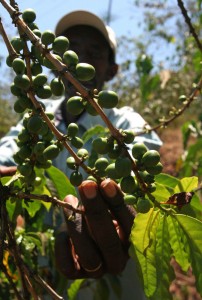Sustainable Coffee on the Rise, But Harmful Methods More Prevalent

Thomas Mukoya/Reuters/Landov
As global demand rises for cheap coffee, farmers from regions such as Africa shift to cost effective, yet environmentally harmful methods.
For the past decade, Americans have become more concerned about where their daily caffeine boost comes from.
In fact, a new report from the College of Natural Sciences at the University of Texas says that farmers of specialty coffee, which is often environmentally-friendly, saw sales rise more than 75 percent from 2000 to 2008.
“Shade-grown” coffee uses a traditional farming method that uses a natural canopy of forestry. Environmentalists favor this technique because it keeps the landscape relatively intact and supports native species such as migratory birds.
Mike McKim, owner of Cuvee Coffee, a roaster in the Austin area, attributes the quality of his coffee in large part to shade-grown techniques.
“The better [farmers] take care of their land, the better their coffee is, in general,” McKim says.
But beyond the U.S., consumer demand and a drop in global coffee prices is causing a global shift toward growing the cheap stuff, which is used for instant coffee. According to the report, the “proportion of land used to cultivate shade-grown coffee … has fallen by nearly 20 percent globally since 1996.”
While shade-grown coffee production is growing, non-shade-grown coffee is growing at a much faster rate. And in regions such as Africa and Asia, where coffee production on the whole is increasing, farmers are growing a lot of it.
Compared to shade-grown coffee, the robusta bean – one of the beans used for instant coffee — can tolerate full sun exposure.
In search for lower costs and higher yields, farmers clear forests and pastures to plant high quantities of robusta beans.
Shalene Jha, Natural Sciences professor and lead author of the UT study, says this increasingly-dominant farming technique has its consequences.
Full-sun coffee farms cause deforestation, loss of biodiversity and soil depletion, Jha says. Consequently, surrounding communities have been known to experience flooding and landslides.
The report found that “since 1990, the land area under coffee cultivation has contracted in Africa and expanded in Asia,” mainly in Indonesia and Vietnam. “Most of the new production is done in an intensive style,” the report says.
Jha urges government agencies and conservation groups to help coffee farms in developing countries become members of coffee certification programs. Jha says organizations such as the Bird Friendly certification program from the Smithsonian Migratory Bird Center “go out and visit coffee farms and if they meet environmental standards, they are able to get the certification.”
She says coffee farms then “can increase the price of the coffee and the farmer gets a little bit of a price premium. And many of us buy that coffee because we’re like, ‘oh that’s the way I want my planet to be.'”
Jha hopes that once more farmers take advantage of certification programs, shade-grown coffee may shift from an American fad to a global tradition in coffee drinking.